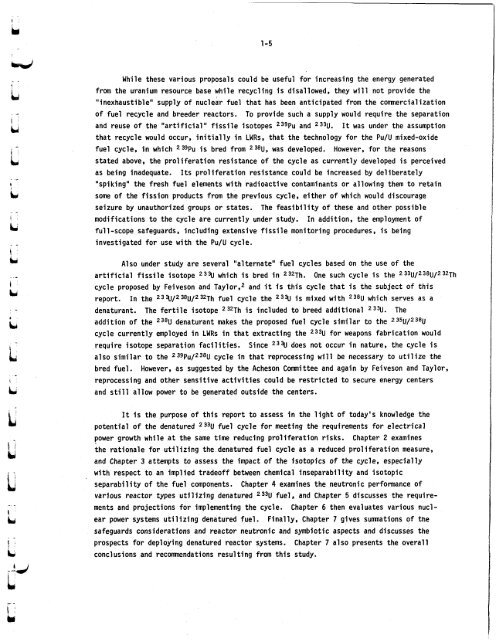ORNL-5388 - the Molten Salt Energy Technologies Web Site
ORNL-5388 - the Molten Salt Energy Technologies Web Site
ORNL-5388 - the Molten Salt Energy Technologies Web Site
Create successful ePaper yourself
Turn your PDF publications into a flip-book with our unique Google optimized e-Paper software.
L<br />
.-<br />
k<br />
id<br />
.-<br />
I<br />
L:<br />
_ -<br />
I<br />
iclr<br />
.-<br />
i<br />
bd<br />
i<br />
id<br />
L<br />
_ -<br />
I<br />
b<br />
.-<br />
I ,<br />
t<br />
--<br />
I'<br />
&<br />
1-5<br />
While <strong>the</strong>se various proposals could be useful for increasing <strong>the</strong> energy generated<br />
from <strong>the</strong> uranium resource base while recycling is disallowed, <strong>the</strong>y will not provide <strong>the</strong><br />
"inexhaustible" supply of nuclear fuel that has been anticipated from <strong>the</strong> connnercial ization<br />
of fuel recycle and breeder reactors.<br />
and reuse of <strong>the</strong> "artificial" fissile isotopes 239Pu and 233U. It was under <strong>the</strong> assumption<br />
that recycle would occur, initially in LWRs, that <strong>the</strong> technology for <strong>the</strong> Pu/U mixed-oxide<br />
fuel cycle, in which 239Pu i s bred from 238U, was developed.<br />
stated above, <strong>the</strong> proliferation resistance of <strong>the</strong> cycle as currently developed is perceived<br />
as being inadequate.<br />
"spiking" <strong>the</strong> fresh fuel elements with radioactive contaminants or allowing <strong>the</strong>m to retain<br />
some of <strong>the</strong> fission products from <strong>the</strong> previous cycle, ei<strong>the</strong>r of which would discourage<br />
seizure by unauthorized groups or states. The feasibility of <strong>the</strong>se and o<strong>the</strong>r possible<br />
modifications to <strong>the</strong> cycle are currently under study.<br />
full-scope safeguards, including extensive fissile monitoring procedures, is being<br />
investigated for use with <strong>the</strong> Pu/U cycle.<br />
To provide such a supply would require <strong>the</strong> separation<br />
However, for <strong>the</strong> reasons<br />
Its pro1 iferation resistance could be increased by deliberately<br />
In addition, <strong>the</strong> employment of<br />
Also under study are several "alternate" fuel cycles based on <strong>the</strong> use of <strong>the</strong><br />
artificial fissile isotope 23% which is bred in 232Th. One such<br />
cycle proposed by Feiveson and Taylor,2 and it is this cycle that<br />
report. In <strong>the</strong> 23%/238U/232Th fuel cycle <strong>the</strong> 23% is mixed with<br />
denaturant. The fertile isotope 232Th i s included to breed addit<br />
addition of <strong>the</strong> 238U denaturant makes <strong>the</strong> proposed fuel cycle sim<br />
cycle is <strong>the</strong> 33U/238U/2 32Th<br />
is <strong>the</strong> subject of this<br />
238U which serves as a<br />
onal 233U. The<br />
lar to <strong>the</strong> 235U/238U<br />
cycle currently employed in LWRs i n that extracting <strong>the</strong> 233U for weapons fabrication would<br />
require isotope separation facilities. Since 23% does not occur in nature, <strong>the</strong> cycle is<br />
also similar to <strong>the</strong> 239Pu/238U cycle in that reprocessing will be necessary to utilize <strong>the</strong><br />
bred fuel. However, as suggested by <strong>the</strong> Acheson Comnittee and again by Feiveson and Taylor,<br />
reprocessing and o<strong>the</strong>r sensitive activities could be restricted to secure energy centers<br />
and still allow power to be generated outside <strong>the</strong> centers.<br />
It is <strong>the</strong> purpose of this report to assess in <strong>the</strong> light of today's knowledge <strong>the</strong><br />
potential of <strong>the</strong> denatured 233U fuel cycle for meeting <strong>the</strong> requirements for electrical<br />
power growth while at <strong>the</strong> same time reducing proliferation risks. Chapter 2 examines<br />
<strong>the</strong> rationale for utilizing <strong>the</strong> denatured fuel cycle as a reduced proliferation measure,<br />
and Chapter 3 attempts to assess <strong>the</strong> impact of <strong>the</strong> isotopics of <strong>the</strong> cycle, especially<br />
with respect to an imp1 ied tradeoff between chemical inseparability and isotopic<br />
separability of <strong>the</strong> fuel components. Chapter 4 examines <strong>the</strong> neutronic performance of<br />
various reactor types utilizing denatured 233U fuel, and Chapter 5 discusses <strong>the</strong> require-<br />
ments and projections for implementing <strong>the</strong> cycle. Chapter 6 <strong>the</strong>n evaluates various nucl-<br />
ear power systems utilizing denatured fuel. Finally, Chapter 7 gives sumnations of <strong>the</strong><br />
safeguards considerations and reactor neutronic and symbiotic aspects and discusses <strong>the</strong><br />
prospects for deploying denatured reactor systems. Chapter 7 also presents <strong>the</strong> overall<br />
conclusions and recommendations resulting from this study.



![Review of Molten Salt Reactor Physics Calculations [Disc 2]](https://img.yumpu.com/21979492/1/190x247/review-of-molten-salt-reactor-physics-calculations-disc-2.jpg?quality=85)












